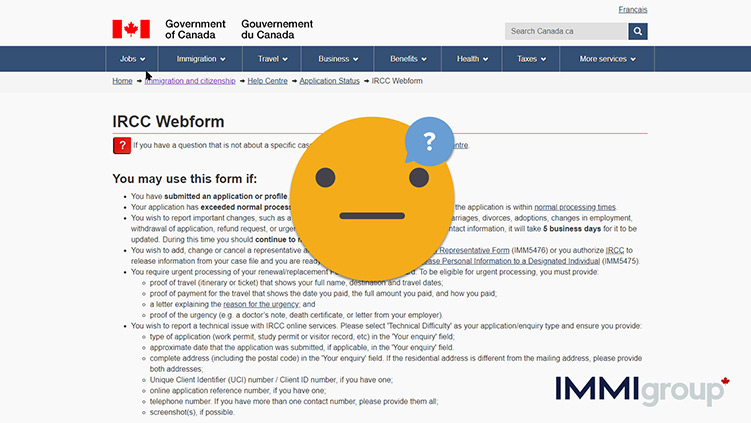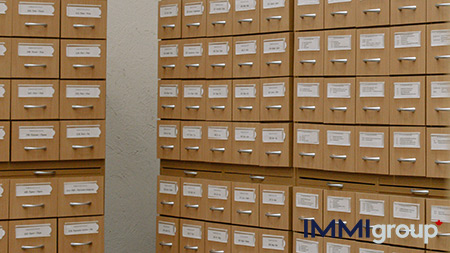Tips and Tricks for Checking Your IRCC (CIC) Application Status

Key Takeaways
- Phoning IRCC to check the status of your application involves delays or even having your call cut off while you are on hold. Additionally, the menu you must navigate to let IRCC know what you’re calling about is tiered and complex and may use other descriptions of the forms or issues you want to talk about.
- Using the e-Client Application Status (ecas) online tool can be helpful but is only permitted for certain types of applications – sponsorships, permanent residence applications, and citizenship applications. So you might not be able to use it.
- Filing an Access to Information and Person Information request with IRCC to see your Global Case Management System (GCMS) notes. This takes longer but can provide very useful information, including seeing if you need to submit additional documents or whether you will be asked to an interview and what you may be asked about.
There are three different routes to check up on the status of your application with Immigration, Refugees and Citizenship Canada (IRCC, formerly CIC). The first option is to call IRCC at 1-888-242-2100. The second option is to use IRCC’s e-Client Application Status online tool at IRCC’s website. The other route is to file a request to see your GCMS notes directly to IRCC. What are the differences between these two alternative routes? And what does GCMS mean?
Index
- Call Immigration, Refugees and Citizenship Canada (formerly CIC)
- Check your status onilne
- Get your GMCS Notes (formerly CAIPS and FOSS)
Phoning IRCC at 1-888-242-2100
The simplest way to check your client application status would seem to be calling IRCC at 1-888-242-2100, however that isn’t really the case.
For one thing, it’s quite hard to call this number if you are outside of Canada, as it’s only available in North America. Click here for the full article “How to call IRCC (Canadian immigration) from outside of Canada”.
But the real problem is that it’s hard to get through. Here are the problems in order:
- When you call, there is a long, tiered menu system, so you need to know what you are calling about, that is, you need to know what IRCC calls the application you are calling about. If not, you may not find your way to an operator.
- IRCC’s call centre is often extremely busy so you can be on hold for hours and sometimes the system will just disconnect your call.
- Once you do get through, you have to prove to the operator that you are who you say you are, so you’ll need your UCI or application number, in addition to being able to answer certain questions about yourself (such as your birth date).
- Once your identity has been confirmed, the call centre staff member will only be able to tell you the vaguest details about your file, such as whether or not it was received, whether or not it is being processed, or whether or not there has been a decision on your application (and if a document has been sent).
This experience often leaves people unsatisfied. So what other options are there if you wish to check your spousal sponsorship application status or your citizenship application status, for example ?
IRCC e-Client Application Status
This online tool available at IRCC’s website is not, in fact, available to all applicants. Whether or not you can access the ecas application status tool depends on what you applied for with IRCC:
- Applications eligible to use the e-Client Application Status
- Sponsorship of a member of the Family Class;
- Permanent Residence from within Canada for all categories;
- Permanent Residence from outside Canada for all categories;
- Permanent Resident Card;
- Citizenship application;
- Citizenship application for person adopted by a Canadian;
- Citizenship Certificate application;
- Application to renounce Canadian citizenship;
- Application to resume Canadian citizenship.
- Applications not eligible to use the e-Client Application Status
- Immigration Documents: verification of status, replacements, and amendments of documents; as well as: request to amend – record of landing/confirmation of permanent residence
- Citizenship: Search of Citizenship Results category.
For those not eligible to use the e-Client, you must check processing times to see how long in general your application may take. This is not the same as a client application status, which is specific to each individual application. For example, the general processing times for pr card applications is not the same information as your pr card processing status which is information about your specific application for a pr card. Only the ecas tool will allow you to check pr renewal status, for example.
For those eligible to use it, the e-Client Application Status online tool will give you your application’s status, but will not give further information on your file.
If you are indeed eligible to use the e-Client Application Status online tool, you must remember to have available the following information in order to use the e-Client:
- The identification number related to your application whose status you are checking;
- Your surname (last name) as it appears on your application or on your identity documents;
- Your date of birth and your place of birth.
GCMS (formerly CAIPS and FOSS)
There is another route to checking on your application’s status and that is to file an Access to Information and Personal Information Request to see what is called your GCMS notes. Let’s see what each of these terms mean and how you can do this:
- GCMS or Global Case Management System is the new integrated, worldwide electronic data processing system for IRCC that is replacing CAIPS and FOSS. For all visa and citizenship applications from June 2010, CIC (now IRCC) has been processing them on GCMS rather than CAIPS or FOSS. GCMS is designed to process applications both inside Canada and abroad so it is a single integrated system.
Before 2010, the system was split into two, called CAIPS and FOSS:
- CAIPS or Computer Assisted Immigration Processing System was the electronic data processing system that Canadian immigration offices outside of Canada used to process your visa application. CAIPS is now replaced by the Global Case Management System (GCMS) electronic data processing system which CIC (now IRCC) introduced in 2010. Files that were started on CAIPS remain on CAIPS, however. Your CAIPS Notes is an in-depth look at the notes visa officers or other immigration officials have made on your file. While some information is not available to you, it offers far more detail than IRCC’s e-Client system.
- FOSS or Field Operations Support System was the electronic data system that has been used by Canadian immigration officials as well as customs officials within Canada to process applications, as well as having a data base that contains information on areas like medical information, personal data, lost and stolen documents and security-sensitive information. It too has been replaced by GCMS but FOSS notes remain on FOSS.
This means that, if your application was submitted before 2011, to obtain your GCMS notes at IRCC under the Access to Information Act, you must request both your CAIPS & GCMS records, or both your FOSS & GCMS records. This ensures you get at the information that is available, as your file may be on either GCMS or CAIPS or FOSS. If your application is relatively new than it is likely to be on GCMS. If your application was initiated before 2011, then it is likely to be on CAIPS or FOSS.
How to Apply
- You can apply for your GCMS (or CAIPS or FOSS) files through an Access to Information and Personal Information Request. You can download the form here. To send in this form, you must be a Canadian Citizen or Permanent Resident. If you are not a Canadian or a Permanent Resident of Canada, you can find someone you know who is either, and is living in Canada. A Canadian living abroad can also file the Access to Information and Personal Information Request form from outside Canada, but a small fee applies in that case.
- If you are using someone else to file the request, they must fill out the Request form and also get you to fill out and sign a Consent for an Access to Information and Personal Information Request form that you can download from here. Remember that if someone files more than one request on behalf of you, you must sign a separate consent form for each individual request.
- Next, you will need to write a Formal Request letter addressed to IRCC where you actually request the GCMS notes or the notes from the older systems. The Canadian citizen or Permanent Resident will have to provide a copy of their passport or Permanent Resident Card or other documentation as proof as well. The whole package includes:
- The Access to Information and Personal Information Request form: filled out and signed by a Canadian citizen or Permanent Resident, whether yourself or someone else. It must include proof of Canadian citizenship or permanent residence status.
- The Consent for an Access to Information and Personal Information Request form: filled out and signed by you if you are not a Canadian citizen or Permanent Resident.
- A Formal Request letter where you request your GCMS notes from IRCC.
- This should be filed online at https://atip-aiprp.apps.gc.ca/atip/welcome.do or couriered (or sent by registered mail) to the following address:
Immigration, Refugees and Citizenship Canada
Access to Information and Privacy Coordinator
Narono Building
360 Laurier Avenue West, 10th floor
Ottawa, Ontario
K1A 1L1
Canada
The average processing time to receive your GCMS notes is about 4 to 6 weeks. What you will receive back is a screenshot of your files. GCMS are quite long, sometimes up to 30 pages. In both cases they contain some very simple to understand and useful information on the status of your application. But they also contain abbreviations or numbered codes used by Immigration officials and these may need interpreting to help you get the most out of your file. IMMIgroup does requests on GCMS notes, and you can find out more about our services here. (We can also help you get the old CAIPS or FOSS notes if you need them.)
Finally, one of the most useful aspects of an Access to Information and Personal Information Request on your immigration file is it can help you anticipate problems before they happen. For example, once you receive an Acknowledgement of Receipt, AOR, then your file is updated with a preliminary points assessment. A request to see your file can help you see if IRCC has done an accurate assessment of your application, before the formal assessment. That means you can then send in additional documentation, for example, to strengthen your application and ensure that your formal assessment is more positive. This will help your application’s prospects.
Another reason for doing a request is to see why your application has been selected for an interview and this may help you prepare for the upcoming interview. So filing an Access to Information and Personal Information Request is not just a right, but a useful tool to give your application the best possible chance to succeed.
FAQs
How about using your IRCC Secure Account?
This is a newer option (using your online account at IRCC) that we describe in our article here. It is another alternative you can use. You will normally use what is called a (IRCC) GCkey to sign in to provide secure access to your account. Your IRCC my account (IRCC Secure Account) is useful for applying online as well as tracking your application.
If I applied on paper can I link my paper application to my IRCC account?
Yes you can. Our article here provides more information on this. You’ll have to go online to do this.
